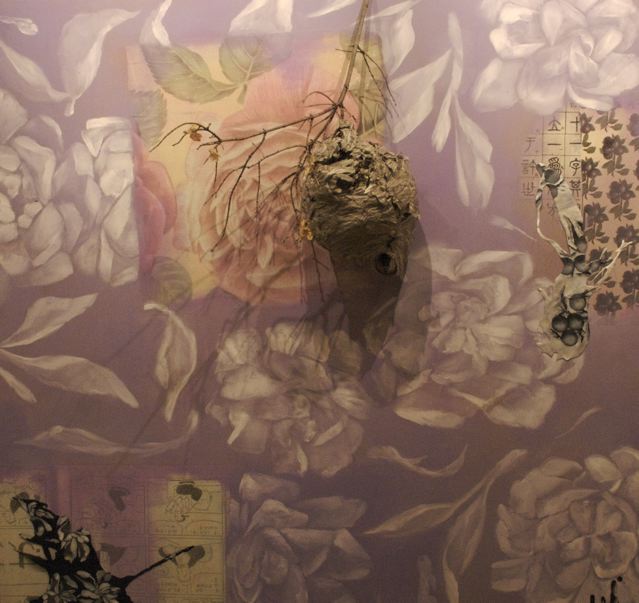
Detail of Jody Guralnick painting with wasp next
Ordinary Wonders and ‘Imbricated” Surfaces for Jody Guralnick
Artist Jody Guralnick lives in Aspen, Colorado in a stone-and-glass house above a glacier-fed river. Once, while I was visiting Aspen and having dinner at Jody’s house, a bear came up to the front door, causing seven astonished guests to turn, gasp and run for the windows – as the bear repaired to private surroundings, the garage, there to finish its meal.
Though truth is always stranger than fiction (and you don’t really know if you can trust me), the facts of hiking are universal; you can trust them from experience. So it suffices that Jody Guralnick, a painter and ceramist (with a work included in the CU Boulder show of Chinese and American women artists), is also a hiker, that is to say a frequent experiencer of the natural world. Her collecting urge is as ubiquitous as nature’s sloughing and extends to gathering nests, leaves, even to eyeing the paint-gobbed legs of her sawhorse, with surgeon’s scalpel in hand.
In Aspen, as anyplace alpine, the earth surface in non-gelid months demonstrates things that have occurred during snow season. Hiking (or walking, while looking down) reveals nature’s tendency to accrete. Ubiquitous pine needles heap, having been scratched into piles by small creatures; lumpen pine cones scatter across spongy leaf beds. This touches closely for the artist – who conducts in parallel a practice of painting, and of patterning ceramic dinnerware – on art as interrogation of physical elements and their spatial and pattern relationships. Guralnick, who went to art school in London, reflects “an incredible sense of discovery” in this investigation. In learning the word “imbricated” – the overlapping structure of certain elements, such as roof tiles or scales of a pine cone – she thinks examination.
“I thought, I’m going to imbricate things myself,” Guralnick recalls, about first picking up her surgeon dad’s scalpel and the pine cone. Having shaved the scales from their structure, she then re-arranges them into elaborately reconditioned structures of her own. The Asian connection that found her curated into the CU Boulder show, she reflects upon as a preference for pattern overall (such as in Asian textiles, “the lowbrow aspect to how things are printed, cheap paper, bright colors slightly off register.” )
For a painter who paints all the time, a hiker for whom “every wasp nest jumps out at me,” the images now include the seep of things that run into the artifice of representation and even command that artifice. “I get what I’ve been walking through; I get it on every level now,” Guralnick says.


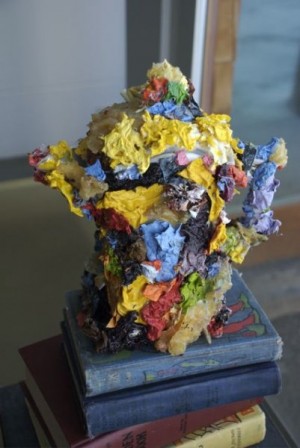
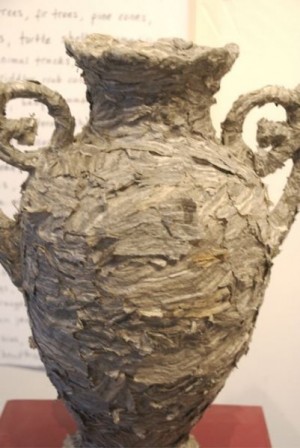

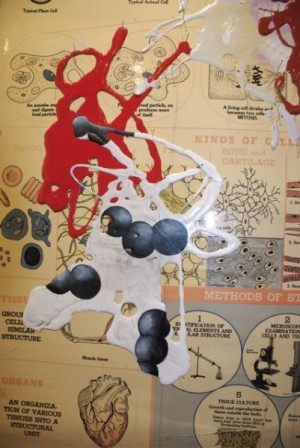

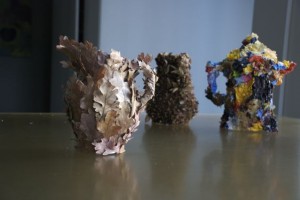
This is such a great glimpse into one of the many ways I can see Jody’s process and an enlightening one. I can walk through the defrosting hillsides in my mind, the “non-gelid” surfaces are below me as I scan ahead. And I stoop to pick up a treasure to share. Thanks for the insights and the new word. On researching gelid I found an unrealted but interesting word – Schadenfreude (pronounced /ˈʃɑːdənfrɔɪdə/ Audio (US) (help·info), German pronunciation: [ˈʃaːdənˌfʁɔʏdə]) is pleasure derived from the misfortunes of others.[1] I feel we may be guilty of schadenfreude with too much celebrating of the death of you know who.
Just great work!
Trackbacks for this post